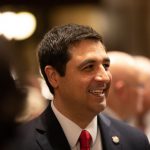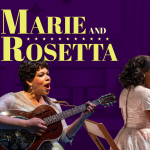A tempestuous “Tempest,” after Haydn and Brahms
Paul Moravec did not translate Shakespeare’s narrative into music in his Tempest Fantasy. He used Shakespeare’s characters as the impetus to spin his own fantastical sound world.
Clarinetist William Helmers and the Prometheus Trio — violinist Timothy Klabunde, cellist Scott Tisdel and pianist Stefanie Jacob — forged boldly into that sound world Monday night. A capacity audience went alolng for the wild ride.
Moravec might be a little old-fashioned in some respects — the music is tonal, the harmonies fairly conventional, the instrumental techniques time-honored. But he takes all the instruments to extremes of range and virtuosity and concocts such crazy textures and colors that the music sounds fresh, like a logical but unforeseen extension of Debussy.
Moravec did not re-tell the play, and I won’t either; click here if you wish to brush up your Shakespeare. All you really need to know for the first movement is that Ariel is a darting magic fairy, and you’ll know that those dazzling fifths that flit up and down the keyboard speak of dazzling flight, as do antic violin and clarinet runs across three octaves.
The second movement gives us the brooding Prospero. The harmonies don’t give us the blues, but the low-down groaning in cello and piano and the slow-drag rhythms get close. From those depths, Moravec ascends so subtly that we don’t know how we arrived atop an ethereal, high violin solo, to which Klabunde gave a marvelous, otherworldly hue.
Helmers switched to bass clarinet for the monstrous Caliban, for music that slithered and jabbed and dashed ahead in a grotesque, unbalanced gait. But a poetic line from Caliban inspired Sweet Airs, a delicate tracery inspired by the songs of birds, wind and water. A soaring violin melody becomes an ardent duet. The clarinet murmurs beneath and rises into the mix on a cushion of gentle piano chords.
The final fantasia mixes all of the above, rather as Shakespeare pulls together his many plots and far-flung characters at the end of his yarn. This is the topper, of course, the wonder of wonders. Caliban lurched, Ariel looped the loop, storms raged, birds sang, all in the most dazzling and complicated musical language. The players, in total control to this point, had to hang on to the railings here. The zillions of notes weren’t the problem. The problem was that they didn’t quite conserve their energy enough to put the music over the top when it needed to go over the top. They came within inches in a no-guts no-glory run at an enormously difficult piece. Great stuff for the first public performance; I wouldn’t be surprised if they nailed it at the repeat, at 11 a.m. Tuesday.
The Prometheans filled the first half with Haydn’s Trio in C and Brahms’ Trio in C minor.
Klabunde, Tisdel and Jacob showed complete mastery of both. They brought a homespun, rustic air to Haydn’s jolly piece, two boisterous dancey movements surrounding a serene glide.
Brahms’ rhythmic subtleties were not wasted on the Prometheus Trio. You could really feel those cross-rhythms, that sense of one voice being in a different meter, of being displaced in time from the others. The disquieting sensation of that displacement carries an ambiguous but potent emotional charge unique to Brahms. It was very present Monday night.
The Prometheus Trio is in residence at the Wisconsin Conservatory of Music, where this program took place. It will be repeated at 11 a.m. Tuesday, Feb. 14. Call 414 276-5760.
Display image on the A&C page: Rembrandt’s Christ in the Storm on the Lake of Galilee. Public domain via Wikipedia Commons.
Get more out of TCD: Check out our User Guide/FAQ.
























thanks, Tom!!!
some of us were seriously wondering of this Moravec wasn’t an answer to the Met’s similarly-themed “Enchanted Island”, but I guess this was just a coincidence. I, for one, am ready to follow William Helmers anywhere–the more radical the better.
The Haydn immediately brought to mind it being played to a box of pseudo-nonchalant kittens. Just couldn’t get that image of out of my mind.
I thought the Brahms was a great outlet for Scott Tisdale–he seems to have a special empathy for Brahms’ shrill falsetto whining which seems all the more grinding for sitting in the cello register. It is on record that Brahms was a high-voiced man–it is heard on a recording and was also heard when he had to pay up for certain….um…personal services.
Stefanie got great, spacious chasms of Brahmsian schizoid out of the piano. Timothy Klabunde has the sense not to clutter the flow with excess vibrato when this kind of lurching is going on. He has a kind of innate spiritualistic tone purity hard to describe, but it is by no means simplistic for being level and continuous but instead akin to Karajan’s ethic, and I don’t want to repeat myself but it has to do with a virtual “tissue” in the music.
Stefanie has a great way with the Joplin arrangement that they all played as a character piece for an encore–an adapted score that was rediscovered which invites a variety of instruments though it clearly favors the piano. I especially liked the swing aspect brought by her expert pedalling of it. This particular setting of it isn’t bordello Joplin, but closer to what one might expect to to hear in such places as the Oconomowoc bandshell, or grampa’s summer night on the Wilson Center lawn except that it was of course refined down to new standards by skilled players.
I appreciated a slight adjustment in the style of the program notes, where a brief paragraph of cultural interest preceeded further discussion of theory on each piece. You probably can’t get succinct analysis like the ones Stefanie writes Prometheus concerts, [even Senior Ruggieri is brief in this] and theory is really more fun than it looks, but in music, theory serves only to attempt to solve how a composition came to be, how the composer might have come up with the result so that others may more fully saturate their delusions by emulating and/or parasitizing off of the compositional skill of the Great Ones. At its best, it is a scientific, open-ended after-study for the elite, and the narrower, the finer-focussed and more measure-specific the better.
apologies for typo error in the third paragraph of my response : should be Scott Tisdel. I must have been imagining Strini-drawl.